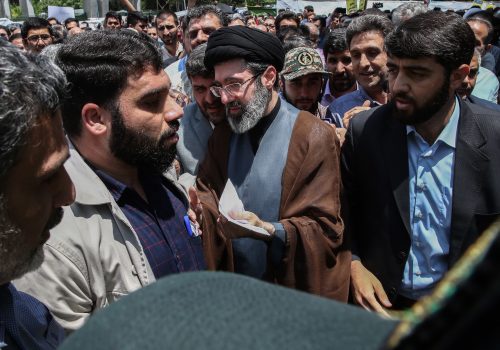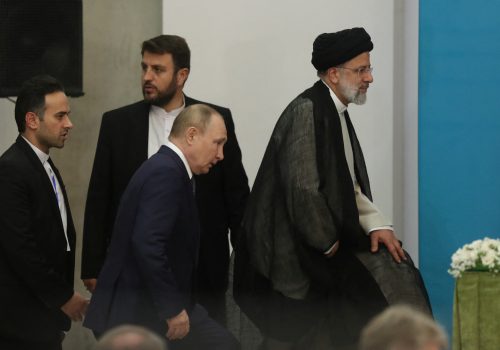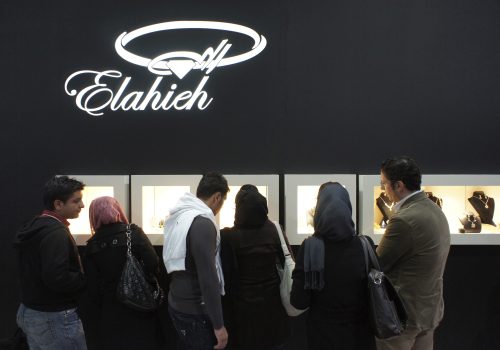Iran’s president let it slip that inflation is at least 60 percent. Here’s how it happened.
Iranian President Ebrahim Raisi is not known for making news in his comments to the press. But on August 28, Raisi accidentally did so when he spoke in detail about the Iranian economy.
Repeatedly, Raisi appeared confused about numbers and percentages, perhaps due to an inadequate briefing from advisers or his misunderstanding of economic indicators. As a result, he unintentionally divulged confidential information about the real inflation rate in Iran, which is at least 60 percent.
Two entities in Iran are tasked with calculating the Consumer Price Index (CPI), the index measuring the average change in market prices for a basket of consumer goods and services. This index is used to calculate the monthly inflation rate as well as the rate over a twelve-month period.
The Central Bank of Iran (CBI) has been compiling the CPI since 1937 but was ordered not to continue to publish its calculations in 2018. The apparent reason was the United States withdrawal from the Iran nuclear deal and reimposition of sanctions, which caused inflation to spike. The Central Bank has continued to calculate the CPI, but the results are classified and divulged only to the highest-ranking officials. The CBI has removed from its website sixteen-page monthly CPI reports dating back decades and now has only a single table with the average annual rate. The Central Bank also stopped publishing a number of other economic indicators, including crude oil sales, foreign exchange earnings, and investment.
The other entity tasked with calculating economic indicators is the Iran Statistics Center. But its inflation figures have been consistently lower than those reported by the Central Bank. In the past few years, the center has been accused of manipulating and underestimating its CPI for political reasons, but its director has denied these allegations, even calling it a “great sin” and swearing to God that he has not done so.
It is likely that the CBI and Statistics Center use different baskets of goods and services to come up with their respective rates. They may also give different weights to price changes in urban versus rural locations. While Iranian data is obviously not perfect, it compares favorably with other countries in its region, according to the World Bank.
However, there are serious real-life consequences to declaring different inflation rates. By law, the Iranian government is obliged to adjust wages and salaries annually to keep pace with inflation. This adjustment is included in annual budgets, ratified by the parliament, and implemented in the first month of the Iranian new year (March). However, because the Central Bank figures have been consistently higher than those of the Statistics Center, the CBI stopped publishing its figures four years ago and the inflation rate reported by the Statistics Center became the basis of the wage adjustments. For example, the average annual inflation rate for the Iranian year ending in late March 2018—the last year of Central Bank reporting—was 9.6 percent, while the one reported by the Statistics Center was 8.1 percent.
The failure of the government to keep wage raises in line with inflation has led to numerous protests since Raisi took office.
The manipulation of economic statistics for political reasons dates to the mid-2000s when hardliner Mahmoud Ahmadinejad became president. During his term in office, inflation figures and items such as unemployment rate and capital flight were all underreported. As a result, many independent economists have disregarded government statistics and warned that policies based on falsified statistics will fail.
At the August 28 press conference, newspaper reporters grilled Raisi about the government’s decision to eliminate an artificial official exchange rate for the Iranian rial, which led to double-digit increases in consumer prices in a matter of weeks. Even the Statistics Center could not disguise inflation of nearly 14 percent in one month. Attempting to defend his government’s decision, Raisi asserted that the inflation rate had actually fallen since he took office in August 2021 and that the May-July period were exceptions. In doing so, he disclosed the inflation rate as reported by the Central Bank—the higher rate—for the month he took office in September 2021 and compared it with the lower one reported by the Statistics Center, for August this year, to falsely conclude that he was able to bring down inflation during his first year in office. Specifically, Raisi said, “the inflation rate has dropped by 20 percentage points in the 12 months of my government. The current rate is 40.5 percent, but the rate twelve months ago was approximately 60 percent.”
Newspapers immediately pointed to his confusion of indicators by reporting that he had given not only annual rates from two different entities for two different months but also disclosed confidential information on live television. Raisi had compared the confidential Central Bank figure of a 60 percent annual rate as measured in September 2021 with the Statistics Center figure of a 40.5 percent annual rate as measured in August 2022.
The next day, Central Bank Governor Ali Saleh-Abadi defended Raisi by confirming that, in September 2021, the inflation rate, “according to Central Bank calculations,” was approximately 60 percent and had fallen by 20 percentage points in Raisi’s first year in office. Until then, the Iranian people did not know that the inflation rate was actually 60 percent last year.
Raisi’s confusion with numbers, his unintentional disclosure of the inflation rate, and the attempt of the CBI governor to cover up his boss’ ineptness and take the blame became grist for jokes, with many noting that Raisi, although having received religious training in Shia seminaries, only had a middle school secular education—something disclosed by Mohsen Mehrali-Zadeh, one of his rivals for the presidency in the 2021 campaign.
To counter these jokes about “sixth graders,” as well as Raisi’s poor performance at his news conference, the government newspaper Iran published a report blaming former Central Bank governor Abdolnaser Hemmati, who also ran against Raisi in 2021, as well as Hemmati’s boss, former President Hassan Rouhani, for the runaway inflation. Hemmati then published a post on his Instagram page, asking how Raisi managed to bring down inflation by 20 points without him or the current CBI governor noticing it for twelve months.
Raisi’s administration has been noteworthy for its poor quality of cabinet ministers, many of them drawn from the inept Ahmadinejad period.
The latest incident once again underlined Raisi’s inarticulateness and lack of governing expertise, as well as the dire state of the economy, which have undermined not only his presidency’s chances for success, but his ambitions to become Supreme Leader when Ayatollah Ali Khamenei passes away.
The author, who is well-versed in the Iranian political scene, was granted anonymity to share candid observations.
Further reading
Wed, Sep 7, 2022
Rumors of Mojtaba Khamenei being crowned with the Supreme Leader’s turban have been circulating for years. Now it may happen.
IranSource By
As President Ebrahim Raisi has stumbled, the prospects of the only other likely candidate for Supreme Leader have advanced. Attention is now focused on Ayatollah Ali Khamenei’s second son Mojtaba, who seemed from the outset to be orchestrating Raisi’s presidency.
Thu, Aug 25, 2022
The Ukraine war has made Iran and Russia allies in economic isolation. Here’s how.
IranSource By
A now heavily-sanctioned Russia may seem a weakened strategic partner for Iran; however, the imposition of western sanctions and the demonization of Russia may bring Moscow and Tehran closer as mutual enemies of the United States and NATO-led international framework.
Wed, Aug 3, 2022
Amongst Iran’s super-rich are tax evaders too. And the government isn’t doing much about it.
IranSource By
Given Iran’s economic crisis, there is widespread public resentment of the ability of the super-rich to avoid paying taxes.
Image: An Iranian family wearing protective face masks walk along a street-side near Tehran’s Traditional Grand bazaar amid the COVID-19 outbreak in Iran on January 27, 2021. (Photo by Morteza Nikoubazl/NurPhoto)


